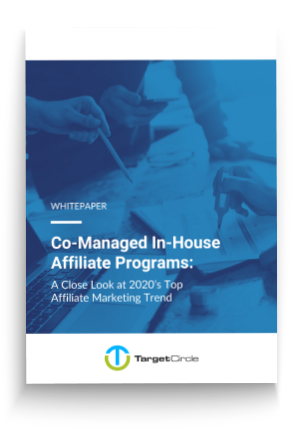

Heiko Hildebrandt
My name is Heiko Hildebrandt. I'm located at the Target Holding headquarters in Lillestrøm, Norway. Since 2014 I have been CEO at Target Circle.
Share this post
Share on facebook
Share on twitter
Share on linkedin
Share on whatsapp
Become a master in commission models
In the affiliate marketing market, there are different commission models, which vary according to the marketing objective of the company or advertiser. Contrary to what is often believed, affiliate programs are not only for physical or digital products but also for actions and contacts. If the marketing objective of a company is to generate registrations of potential people interested in buying a product, for example, that company can launch an affiliate program that pays a fixed amount for each registration made. The company would not be promoting a product, but a specific action, like filling out a registration form.
There are also differences in the disclosure strategies of an affiliate when the objectives are actions or conversions. Each marketing objective and commission model obliges, automatically, the adoption of a different divulgation strategy. When entering this market, you should look for the commission models that make more sense for you and your digital marketing strategy.
There are also differences in the disclosure strategies of an affiliate when the objectives are actions or conversions. Each marketing objective and commission model obliges, automatically, the adoption of a different divulgation strategy. When entering this market, you should look for the commission models that make more sense for you and your digital marketing strategy.
Table of Contents
1. CPC (cost per click)
The CPC (cost per click) commission model is one of the oldest on the Internet. When Google decided to launch Google AdWords on October 23, 2000, this commission model became widely used in the world. Together with Google AdWords, Google launched the Google Adsense program, which is nothing more or nothing less than an affiliate program that pays per click on text or image ads.With CPC, the affiliate receives a fixed or variable amount each time the advertising banner or text link receives a click from a user. This model has the advantage that the affiliate is not dependent on the final result, i.e. the user buying the product, but has the disadvantage of being a difficult model to scale since earning a lot of money would require hundreds of thousands of clicks.
2. CPM (cost per thousand impressions)
The commission per thousand impressions model was widely spread when the internet reached the general public. In this commission model, the affiliate received a fixed amount for every thousand impressions of an advertising banner, regardless of whether the user clicked on the banner or not. Logically, in the 80’s and ‘90s, the number of clicks on advertising banners was very high, with click-through rates reaching 96%, which invariably made most users click on ads.This model started to be used in practically all major portals and media, which sold their advertising spaces in the CPM model to their advertisers, because they considered that the user who browsed their sites was already being impacted by these ads, simply by viewing them, even if he did not click. Even today, the value of CPM is used in advertising platforms like Facebook and Google AdWords and is an extremely important metric for performance and cost analysis. Moreover, it is impossible to define the click rate (CTR) of an ad without taking into account the number of impressions of it.
3. CPA (cost per action)
The commission-per-action model, much known as the CPA commission model, is one of the most popular and effective commission models in affiliate marketing. In this model, the affiliate only receives their commission when the user clicks on the banner or link and performs a specific action, which may be the completion of a form, the purchase of a product, or any other action.Generally speaking, the CPA model is associated with the purchase of products, in which the producer shares a fixed commission value for the generation of sales of the product. This model is one of the best paying models, and several affiliate programs are offering very high CPA values, with commissions reaching $800 in CPA.
4. CPS (cost per sale)
The sales commission model is widely used in e-commerces affiliate programs, it means that once the publishers made a sale of the advertiser’s product, they will receive a commission based on the percentage of the sales or a fixed amount already determined before.For those who work with affiliate marketing, this commission model is very interesting, because you receive a commission on all purchases that the user makes during your session after clicking on your advertising banner or your affiliate link.
5. CPL (Cost per lead)
The CPL model is extremely used in B2B businesses, where the objective is to capture contacts from potential new customers. In this commission model, as a rule, the affiliate receives a fixed amount for each lead generated. This model is also widely used in mobile applications, which pays a fixed commission to each lead generated in its application.Other examples for a commission model by leads would be recruiting companies that are looking for professionals to fill a certain job vacancy, companies that are looking for more budget requests, companies that intend to generate more registrations in the Trial version of their software, etc. In all these cases, the affiliate receives a fixed commission for generating this lead, regardless of whether this lead becomes a client or not.
6. CPI (cost per install)
The CPI commission model only appeared when smartphones and mobile applications began to emerge. It is a commission model focused on mobile traffic, in which the affiliate receives a fixed commission for generating installations of a particular application. There are several companies dedicated to this niche market, with dozens of different application offerings and in different areas, which the affiliate can promote in its mobile traffic.The objective of this type of commission model is to generate the installation of the application on the user’s smartphone, even if the user uses this application or not. The affiliate receives a commission for the installation and not for the use of the application.
7. CPE (Cost Per Engagement)
The Cost Per Engagement commission model, known as well as CPE, is a model based on how the users engage with the application or ads. It is really common for incentive traffic to run campaigns based on engagement, such as “reach level 5” from a game or “sign up for a music subscription”. The fee is based on a how many users will perform a certain action.8. RevShare (Revenue Sharing)
The Revenue Sharing model, better known as RevShare, is a commission model in which the affiliate receives a percentage commission on the acquisitions made by users. This model is extremely used in sports betting sites, porn sites, relationships, stock investments, forex, etc.This commission model is extremely interesting because it is recurring, that is, when the affiliate generates a user for a relationship site and that user purchases a subscription. Whenever he renews the subscription, the affiliate receives his commission. When the user cancels the subscription, the affiliate no longer receives their commission.
Related articles
Share this post
Share on facebook
Share on twitter
Share on linkedin
Share on whatsapp
Recent posts
Follow us
Subscribe to our newsletter










